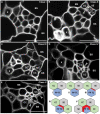Asymmetric wall ingrowth deposition in Arabidopsis phloem parenchyma transfer cells is tightly associated with sieve elements
- PMID: 35609084
- PMCID: PMC9467654
- DOI: 10.1093/jxb/erac234
Asymmetric wall ingrowth deposition in Arabidopsis phloem parenchyma transfer cells is tightly associated with sieve elements
Abstract
In Arabidopsis, polarized deposition of wall ingrowths in phloem parenchyma (PP) transfer cells (TCs) occurs adjacent to cells of the sieve element/companion cell (SE/CC) complex. However, the spatial relationships between these different cell types in minor veins, where phloem loading occurs, are poorly understood. PP TC development and wall ingrowth localization were compared with those of other phloem cells in leaves of Col-0 and the transgenic lines AtSUC2::AtSTP9-GFP (green fluorescent protein) and AtSWEET11::AtSWEET11-GFP that identify CCs and PP cells, respectively. The development of PP TCs in minor veins, indicated by deposition of wall ingrowths, proceeded basipetally in leaves. However, not all PP cells develop wall ingrowths, and higher levels of deposition occur in abaxial- compared with adaxial-positioned PP TCs. Furthermore, the deposition of wall ingrowths was exclusively initiated on and preferentially covered the PP TC/SE interface, rather than the PP TC/CC interface, and only occurred in PP cells that were adjacent to SEs. Collectively, these results demonstrate a tight association between SEs and wall ingrowth deposition in PP TCs and suggest the existence of two subtypes of PP cells in leaf minor veins. Compared with PP cells, PP TCs showed more abundant accumulation of AtSWEET11-GFP, indicating functional differences in phloem loading between PP and PP TCs.
Keywords: Arabidopsis; AtSUC2; AtSWEET11; companion cells; minor vein; phloem loading; phloem parenchyma transfer cell; sieve elements; wall ingrowths.
© The Author(s) 2022. Published by Oxford University Press on behalf of the Society for Experimental Biology.
Figures








Similar articles
-
Review: More than sweet: New insights into the biology of phloem parenchyma transfer cells in Arabidopsis.Plant Sci. 2021 Sep;310:110990. doi: 10.1016/j.plantsci.2021.110990. Epub 2021 Jul 8. Plant Sci. 2021. PMID: 34315604 Review.
-
Heteroblastic Development of Transfer Cells Is Controlled by the microRNA miR156/SPL Module.Plant Physiol. 2017 Mar;173(3):1676-1691. doi: 10.1104/pp.16.01741. Epub 2017 Jan 12. Plant Physiol. 2017. PMID: 28082719 Free PMC article.
-
Sucrose regulates wall ingrowth deposition in phloem parenchyma transfer cells in Arabidopsis via affecting phloem loading activity.J Exp Bot. 2020 Aug 6;71(16):4690-4702. doi: 10.1093/jxb/eraa246. J Exp Bot. 2020. PMID: 32433727
-
High-resolution confocal imaging of wall ingrowth deposition in plant transfer cells: Semi-quantitative analysis of phloem parenchyma transfer cell development in leaf minor veins of Arabidopsis.BMC Plant Biol. 2015 Apr 23;15:109. doi: 10.1186/s12870-015-0483-8. BMC Plant Biol. 2015. PMID: 25899055 Free PMC article.
-
Foliar sieve elements: Nexus of the leaf.J Plant Physiol. 2022 Feb;269:153601. doi: 10.1016/j.jplph.2021.153601. Epub 2021 Dec 17. J Plant Physiol. 2022. PMID: 34953412 Review.
Cited by
-
Camalexin accumulation as a component of plant immunity during interactions with pathogens and beneficial microbes.Planta. 2022 May 5;255(6):116. doi: 10.1007/s00425-022-03907-1. Planta. 2022. PMID: 35511374 Review.
-
The Arabidopsis leaf quantitative atlas: a cellular and subcellular mapping through unified data integration.Quant Plant Biol. 2024 Feb 29;5:e2. doi: 10.1017/qpb.2024.1. eCollection 2024. Quant Plant Biol. 2024. PMID: 38572078 Free PMC article.
References
-
- Amiard V, Demmig-Adams B, Mueh KE, Turgeon R, Combs AF, Adams WW 3rd. 2007. Role of light and jasmonic acid signaling in regulating foliar phloem cell wall ingrowth development. New Phytologist 173, 722–731. - PubMed
-
- Cayla T, Le Hir R, Dinant S.. 2019. Live-cell imaging of fluorescently tagged phloem proteins with confocal microscopy. Methods in Molecular Biology 2014, 95–108. - PubMed
Publication types
MeSH terms
Substances
Grants and funding
LinkOut - more resources
Full Text Sources
Molecular Biology Databases
Miscellaneous

